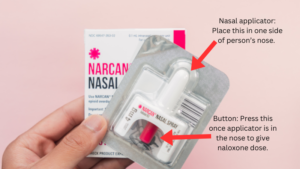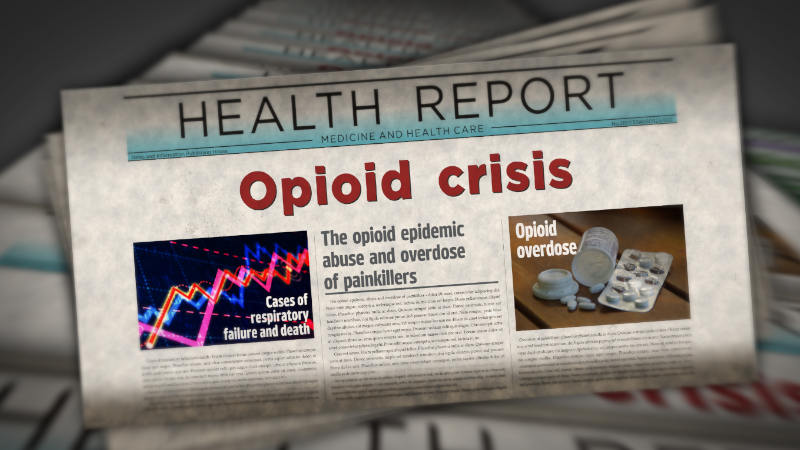- The drug supply is becoming more toxic due to fentanyl. Fentanyl is a very potent opioid found in most illicit pills. This increases risk of overdose.
- Adolescent overdose deaths are increasing. It is important all families, caregivers, and adolescents know how to recognize an overdose and respond using naloxone.
- Naloxone is safe, easy to use, and available over the counter.
- Harm reduction strategies, including medications to treat opioid use, help reduce the risk of deadly overdose.
What are opioids?
Opioids and opiates are very powerful medications that come from the opium poppy plant (opiates) or are synthetic drugs that look like molecules from the opium plant (opioids). In this section, we’ll use the term “opioids” to refer to opiates and opioids. These drugs can be taken by mouth in a pill form, inhaled/snorted, or injected.
When used as advised by a doctor, opioids can treat pain. But some people take opioids in higher amounts or more often than prescribed to deal with pain, trauma, mental health symptoms, and physical dependence on opioids. Adolescents may take pills to experiment, because their friends are trying them, or because they don’t know how dangerous it could be. Opioids used inappropriately may cause overdose and even death.
What is fentanyl?
Fentanyl is an incredibly potent (or strong) opioid. It is now found in most opioid pills sold in illicit drug markets. It may also be added to stimulants such as cocaine or methamphetamines.
Fentanyl is much more likely to cause a fatal overdose than less potent opioids, like oxycodone.
How can I talk to my adolescent about opioids and related risks?
First, it is so important you are planning to have this conversation! Teens may not get this information at school or elsewhere, and they need adults in their lives to provide accurate, realistic, and important guidance.
Second, it’s important to provide teens with accurate information that will help keep them safe. Ideally no teenager will ever try drugs, particularly opioids. But teaching them about how to use naloxone won’t encourage them to use drugs, but it may help them save someone’s life.
Third, there are lots of resources available online to help. The National Institute of Drug Abuse and Partnership to end Addiction both have resources for families. The Partnership has a helpline, text message program, and online support groups for concerned parents. The Substance Abuse and Mental Health Services Administration’s “Talk. They Hear You.” campaign provides caregivers with resources to guide these conversations.
Last but not least, families are affected by their loved one’s substance use. There are multiple places you can turn to help, including groups such as SMART Recovery and Families Anonymous.
What exactly is an opioid overdose?
An overdose refers to when someone loses consciousness and is not breathing normally. This can happen when someone takes a high or potent dose of opioids. If not treated immediately, an opioid overdose can lead to death. Fortunately, there are things that we can do to recognize and respond to an overdose.
Why are overdose numbers increasing?
Deaths due to drug overdoses have increased over the last 20 years. In 2021, over 106,000 people died of drug overdoses, including over 1,100 adolescents. The rise in overdose deaths is due to multiple factors:
- It’s a very potent opioid and is more likely to cause a deadly overdose. Sometimes people are exposed to it in other substances and don’t even know it.
- Xylazine. It’s another new drug that increases the risk of overdose. Xylazine is not affected by naloxone (see below).
- There can be challenges to accessing treatments for opioid addiction, particularly medications for opioid use disorder like buprenorphine and methadone. Without treatment, people may use more opioids over time with higher risk of overdose.
- People experiencing stigma and shame related to their opioid use may use opioids alone in secret. This increases the risk that an overdose will not be seen and addressed.
How do I know if someone is having an overdose?
No one wants to think about responding to an overdose, as this can be very scary for us and for teens. But knowing how to respond to an overdose can save someone’s life.
Someone who is having an overdose may be:
- Slumped over if sitting down, or laying down on the floor.
- Not responsive to voice, touch, or pain. Pinch someone’s fingernail or put pressure on the sternum (bony area in the middle of the chest) if you’re not sure.
- Barely breathing. Breaths may be very shallow, only happen every 15-30 seconds, or sound like a gurgling or rattling noise.
- Beginning to turn blue, particularly in the skin around the eyelids, lips, and fingernails.
People who are at increased risk of overdose include people who:
- Have health problems, particularly lung (i.e., asthma) or heart (i.e., congenital heart disease) conditions.
- Use more opioids than their doctor recommended.
- Get opioids from people who are not their doctor.
- Mix opioids with other drugs alcohol or benzodiazepines.
- Change who they are buying drugs from.
- Change the way they use drugs, especially if they go from taking a pill by mouth to injecting.
- Use alone.
- Use again after a period of not using such as while in rehab or the hospital.
What is naloxone?
Naloxone is a safe, easy-to-use medication that can reverse (stop) opioid overdoses. Naloxone comes in a single-use nasal spray applicator. Each is individually wrapped and should not be opened until immediately before using.
What should I do if I think someone is having an overdose?
- Call 911. If someone is slumped over or laying on the ground with shallow or irregular breathing and blue lips/fingernails/eyelids, the most important first step is to call 911. Provide the information you have available about the person you are helping, your location, and how to find you.
- Give Naloxone.
Open the wrapping. Put the nasal applicator side into one side of the nose of the person who is overdosing. Then press the button opposite the nasal applicator. Do not press the button before the applicator is in the person’s nose. Once used, the applicator cannot be reused.

After giving naloxone, give rescue breathing if you feel comfortable with this. If you want to get trained in basic life support, including rescue breaths, you can check out courses offered by the American Red Cross.
If the person does not wake up within 3-5 minutes, give another dose of naloxone.
Continue with rescue breaths and stay with the person until help arrives. Do not leave the person alone. If you do not feel safe and need to leave, place the person on their side.
See the links at the end of this page for videos showing how to use naloxone.
What should I know about naloxone?
Naloxone is incredibly safe. It won’t harm someone if they are not having an opioid overdose. It is therefore important to try it if you think someone might be having an overdose.
Naloxone will only stop an overdose due to opioids. It will not stop an overdose due to benzodiazepines like Ativan or Klonopin, alcohol, xylazine, or other sedatives.
In many other states, Good Samaritan Laws protect people who call 911 and/or provide naloxone from getting into legal trouble. Check out this resource to see the laws in your state.
Where can I get naloxone in the United States?
There are no federal laws on what age you have to be to buy naloxone. Many teens are choosing to carry naloxone in case something happens to their friends or an acquaintance.
Naloxone is now available over the counter, which means anyone can get it from a pharmacy without a prescription. However, it may be expensive – goodrx.com coupons can be helpful to find and use the best price. It is also sold on sites like Amazon. To locate a store that sells naloxone, check out this store finder. You can also ask your primary care doctor or your child’s pediatrician to prescribe it. It may be less expensive when health insurance pays for some of it.
Many community organizations also provide naloxone for free. It can be helpful to call your local Department of Public Health to ask.
Naloxone should remain effective for 2 years (24 months), although exposure to extreme temperatures (i.e., below 32°F or above 104°F) may decrease how long it lasts. If your naloxone expires, it is important to replace it. However, it is important to use any available naloxone in the case of an overdose.
If you are located outside of the US, contact your local health department, community health center, or your doctor to ask about how to access naloxone in your country.
What can people do to prevent overdoses?
While naloxone can help treat an opioid overdose, it is even more important to prevent overdoses from happening in the first place. The most effective way to prevent an overdose is to not take a drug – you cannot overdose by being around an opioid (including fentanyl), touching it, and/or touching someone who used an opioid.
Harm reduction is a “set of practical strategies and ideas aimed at reducing negative consequences associated with drug use”. This includes behaviors that can help prevent overdose. Harm reduction includes treatment, including medications for opioid use disorder. These are the best tools we have to prevent overdoses. Ideally anyone who has an opioid use disorder should get medication treatment.
When people are not using medications for treatment of opioid use disorder, there are other ways to prevent overdose. These include:
- Avoid mixing opioids with other sedatives: Using opioids at the same time as other sedating drugs like alcohol or benzodiazepines can increase the risk of overdose and should be avoided.
- Use fentanyl and xylazine test strips: These test strips are available from harm reduction organizations and online and, if used properly, can detect fentanyl in pills and powders.
- To use these tests, a pill should be crushed and mixed up in a plastic bag before using the strip to test the residue. This ensures the strip tests a mixture of the substances included in a pill.
- On most available strips, 1 line = positive for fentanyl, 2 lines = negative.
- Remember to always read the directions! Similar test strips are available for xylazine.
- Using fentanyl test strips is decriminalized in some states (like Massachusetts), but is still illegal in some states.
- Choosing less potent drugs: People who take pills may be at lower risk of overdose than people who inject or inhale drugs. It may also be useful to avoid pills that have fentanyl in them (see below).
- Start with small amounts and “go slow”: Starting with a very small “test” amount allows people to check the strength of a new drug. Increasing the amount slowly helps to avoid using too much, which could cause an overdose.
- Never use alone: If someone has an overdose when alone, no one can give them naloxone or call 911. It is therefore very important to encourage friends to never use drugs alone. People who use alone can use phone hotlines or apps like Brave or Canary to make sure someone calls 911 if they stop responding.
Resources
- GetNaloxoneNow
- You Can Naloxone Training Videos
- Prescribe to Prevent
- National Institute of Health Naloxone DrugFacts
 Young Men's Health
Young Men's Health